Dogs
Fox or Dog?
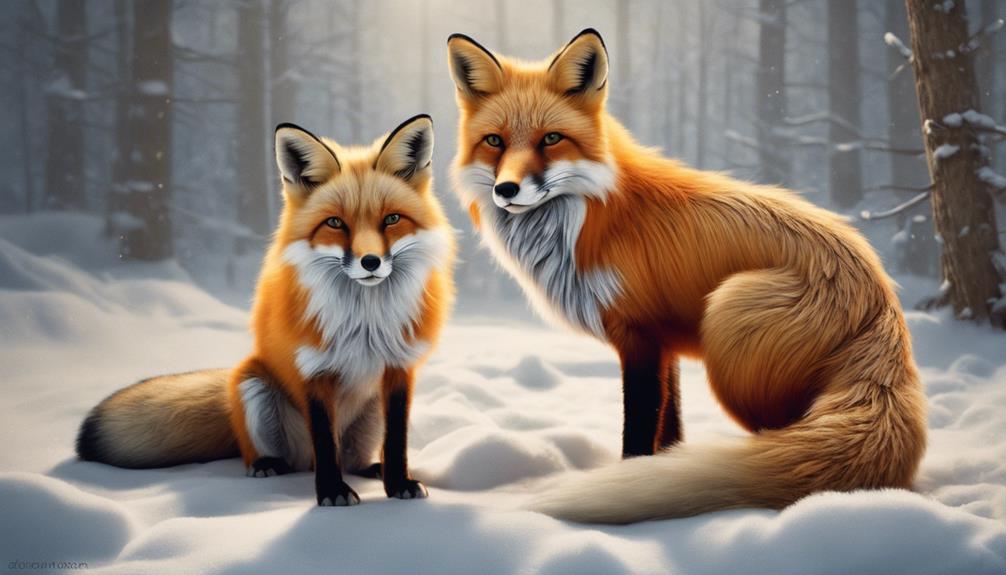
When spotting fox or dog tracks, notice the shape, spacing, and patterns closely. Fox prints are narrow with a diamond shape, while dog tracks are wider and rounded. Foxes space their pads farther apart, making their claws long and thin, unlike dogs with shorter, thick claws. Look for a direct path in fox tracks, versus the random wandering of dogs. Seeing a diagonal trot with hind and front feet separated helps identify a fox. Remember, understanding track details is key. Keep exploring for fascinating insights into distinguishing between these clever canines.
Key Takeaways
- Fox tracks are narrow and diamond-shaped, while dog tracks are wider and rounded.
- Fox pads are smaller and farther apart, while dog pads are closer and more aligned.
- Foxes trot diagonally with hind feet on one side, distinct from dog tracks.
- Fox claws are thin and long with pointed marks, unlike dog claws.
- Examining track patterns and gait differences helps differentiate between fox and dog tracks.
Key Differences in Track Patterns
When observing track patterns, one can easily distinguish between fox and dog prints by noting specific differences.
Fox tracks have elongated prints with a large gap between pads, which sets them apart from dog tracks. Foxes exhibit purposeful and linear patterns in their tracks, unlike dogs that may display more random patterns. Additionally, foxes often have a small straddle with their feet closer to the median line in their tracks, a characteristic not commonly seen in dogs.
Another key difference is that foxes tend to direct register, meaning they place their rear feet where their front feet were, a behavior less frequently observed in dogs. Moreover, foxes trot diagonally, positioning their hind feet on one side and their front feet on the other, which is a distinctive feature that helps differentiate their track patterns from those of dogs.
Fox Vs. Dog Track Shape
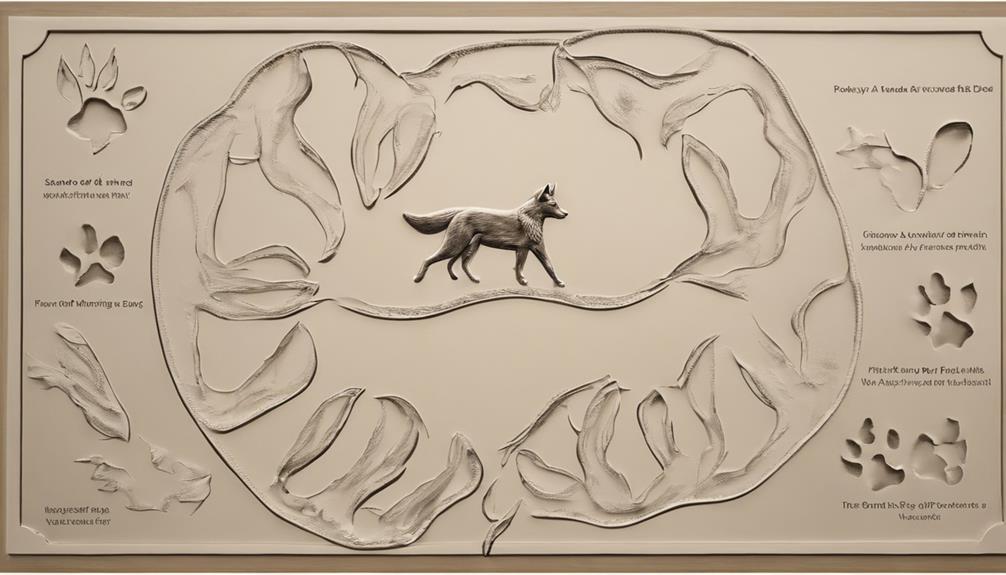
When distinguishing between fox and dog tracks, it's crucial to pay close attention to the shape of the prints.
Fox tracks tend to be narrower and diamond-shaped, while dog tracks are wider and more rounded.
Track Shape Comparison
Comparing the track shapes of foxes and dogs reveals distinct differences in print size, pad arrangement, and claw characteristics. Here is a comparison table showcasing these variations:
| Aspect | Fox | Dog |
|---|---|---|
| Print Shape | Narrow, diamond-shaped prints | Wider, more rounded prints |
| Pad Size | Smaller and farther apart | Larger and closer together |
| Claw Characteristics | Thin and long claws | Short and thick claws |
Understanding these unique features can help differentiate between fox and dog tracks in the wild. Fox tracks often exhibit a purposeful, linear pattern, while dog tracks may appear more random. By observing these distinctions, one can gain valuable insights into the animals' movements and behaviors.
Paw Print Analysis
In analyzing paw prints, one can easily distinguish between fox and dog tracks based on their distinctive shapes and sizes. Fox paw prints are narrower and diamond-shaped, while dog prints are wider and more rounded. Fox pads are smaller and spaced farther apart, with fox claws being thinner and longer than those of dogs.
Additionally, foxes exhibit a more purposeful and linear track pattern compared to dogs, reflecting their wild instincts. Understanding these differences can help in identifying whether the tracks belong to a dog or a wild fox.
Species Identification Differences
By observing the shape and spacing of tracks, we can easily distinguish between fox and dog prints in the wild.
- Fox tracks typically look like foxes with narrower, diamond-shaped prints, while dog tracks appear wider and more rounded.
- The spacing between pads in fox tracks is generally smaller and farther apart compared to dog tracks, aiding in differentiation.
- Examining the spacing between pads is vital as the closer and more aligned pads are in fox tracks, the more likely they're to belong to a fox rather than a dog.
Examining Paw Print Spacing
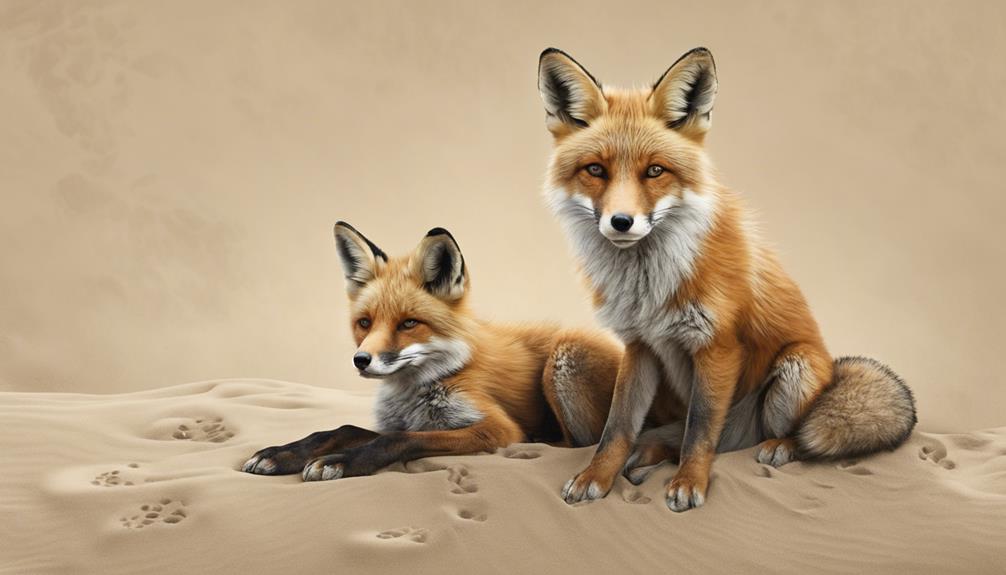
When examining paw print spacing, it's important to pay attention to the alignment of the prints and the length of the tracking stride.
Paw print alignment refers to how the prints are positioned in relation to each other, indicating the animal's gait.
Tracking stride length can show how far apart the prints are from one another, helping determine if they belong to a fox or a dog.
Understanding these key points can assist in accurately identifying the animal behind the tracks.
Paw Print Alignment
Examining paw print spacing reveals distinct differences between foxes and dogs, with fox prints often displaying a direct register and closer alignment compared to the wider gap seen in dog prints.
When analyzing paw print alignment, it's important to note the following:
- Fox paw prints show a direct register, where the rear feet align with the front feet, creating a more linear track pattern.
- Dog paw prints, on the other hand, typically exhibit a wider gap between the front and rear feet, resulting in a less aligned and more staggered appearance.
- The spacing and alignment of paw prints serve as vital indicators for distinguishing between foxes and dogs, providing valuable insights into tracking and identifying these animals based on their unique print characteristics.
Tracking Stride Length
After observing the distinct differences in paw print alignment between foxes and dogs, the focus now shifts to analyzing the tracking stride length, particularly in relation to paw print spacing.
Foxes typically have a smaller stride length between paw prints, showcasing a more precise and deliberate spacing in their tracks. On the other hand, dogs may exhibit a wider stride length with paw prints placed farther apart.
Fur Presence Between Pads
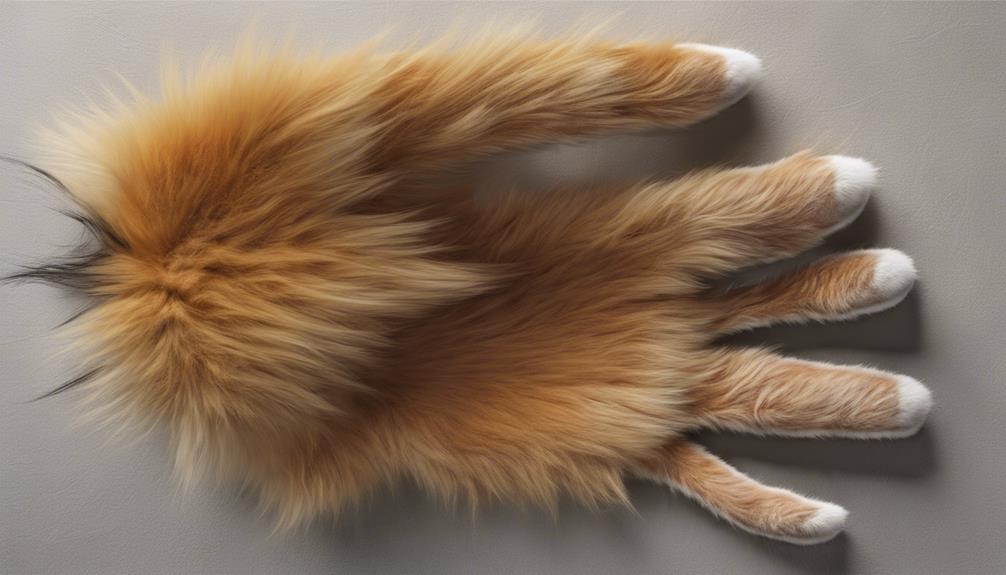
In fox tracks, the dense fur found between the pads serves as a distinguishing feature, particularly noticeable during winter months. This fur presence between the pads is a key characteristic that helps differentiate fox tracks from those of dogs.
- Insulation and Protection: The fur between the pads in fox tracks isn't just for show. It actually provides insulation and protection for the fox's paws, allowing them to navigate through various terrains and weather conditions comfortably.
- Distinct Appearance: Observing the fur between the pads can reveal the distinct appearance of fox tracks compared to those of dogs. This unique feature is a clue that can lead you to correctly identify the animal that left the tracks.
- Identification Marker: When tracking animals, paying attention to the fur presence between the pads is vital. It acts as a reliable identification marker, guiding you towards recognizing whether the tracks belong to a fox or a dog.
Clues From Claw Length
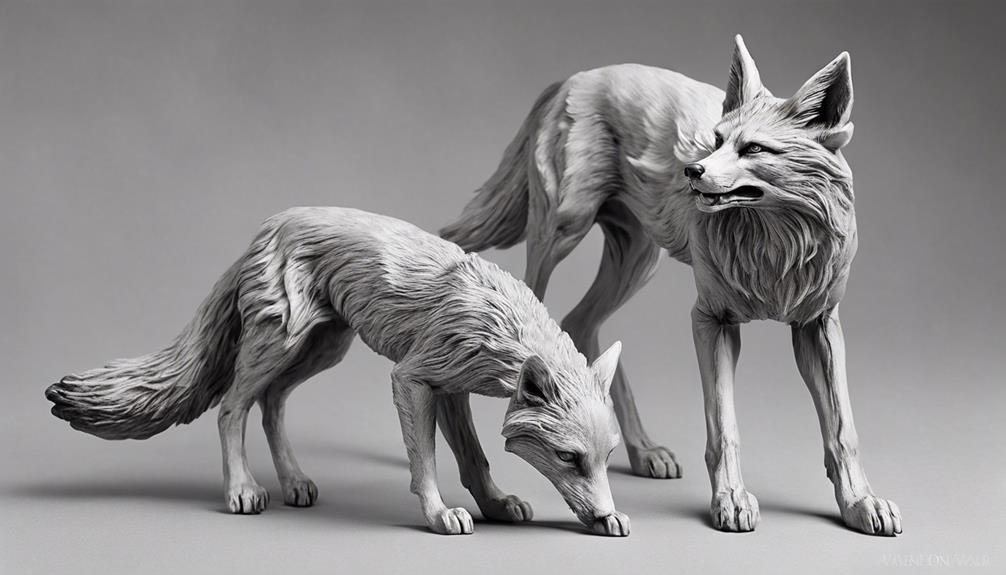
We can easily distinguish between fox and dog tracks by examining the claw length, as fox claws are typically longer and sharper compared to dog claws. When tracking, look for tracks with longer, more pointed claw marks, as this is a clear indication of a fox print.
Foxes, such as the red fox and Arctic fox, rely on their sharp claws for various activities like hunting and climbing. These activities result in distinct claw marks that stand out in their tracks. On the other hand, dogs have shorter and thicker claws, which leave different imprints compared to foxes.
Analyzing Print Size and Shape

Examining the size and shape of prints can provide essential insights into distinguishing between fox and dog tracks.
- Fox prints typically have a narrower, diamond-shaped appearance, while dog prints are wider and more rounded in shape. These distinctions in shape can be pivotal in differentiating between the two animals at a glance.
- Another key difference lies in the paw pads of foxes and dogs. Fox paw pads are generally smaller and placed farther apart, whereas dog paw pads tend to be larger and closer together. Observing these differences can help in accurately identifying the animal responsible for the tracks.
- Additionally, the claws in the prints can also offer clues. Dog claws are often shorter and thicker, while fox claws are more slender. Paying attention to the claw marks left behind in the tracks can aid in determining whether the prints belong to a fox or a dog.
Understanding these nuances in print size, shape, and paw pads is essential in distinguishing between fox and dog tracks accurately.
Gait Variations in Canines
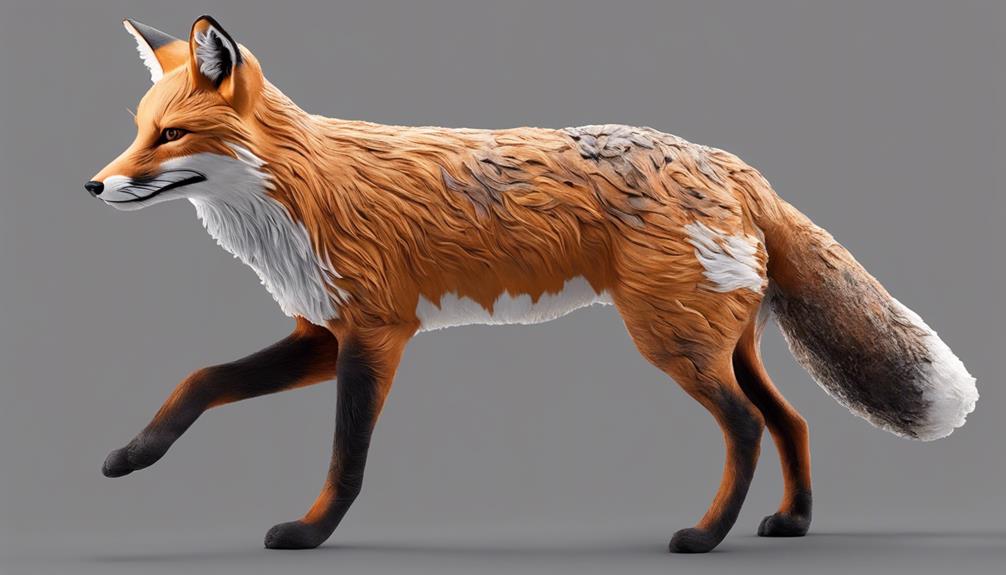
Exploring the distinctive gait variations in canines reveals fascinating insights into their movement patterns and behaviors. Fox species, known for their slender build, exhibit a small straddle, with their feet positioned closer to the median line. When tracking, foxes often engage in direct registering, where their rear feet fall precisely where their front feet were placed. Additionally, foxes trot diagonally, creating a unique track pattern with hind feet on one side and front feet on the other.
Interestingly, domestic dogs may also display similar traits in their track patterns, occasionally trotting at an angle akin to foxes. However, a key differentiator lies in the shape of their prints. Fox prints typically feature a narrower, diamond shape, while dog prints tend to be wider and more rounded. By observing these gait variations and track patterns, one can gain valuable insights into the movements of canines, whether they're foxes or domestic dogs.
Identifying Linear Vs. Random Tracks

In comparing the purposeful and linear tracks of foxes to the more random tracks of dogs, a distinct difference emerges in their movement patterns.
- Fox tracks exhibit a deliberate and intentional path, often showing a straight line with a clear direction, reflecting the fox's focused and strategic movement.
- Dog tracks, on the other hand, tend to meander and wander, displaying a more random and less structured pattern, indicating the dog's exploratory and curious nature.
- The diagonal gait seen in fox tracks, where the hind feet fall on one side and the front feet on the other, is a key distinguishing feature from the more varied gait patterns found in dog tracks.
Understanding these differences can help us decipher the tracks left behind by these animals, providing insights into their behaviors and movements. Following this, we'll explore further into deciphering fox and dog tracks to enhance our understanding.
Deciphering Fox and Dog Tracks
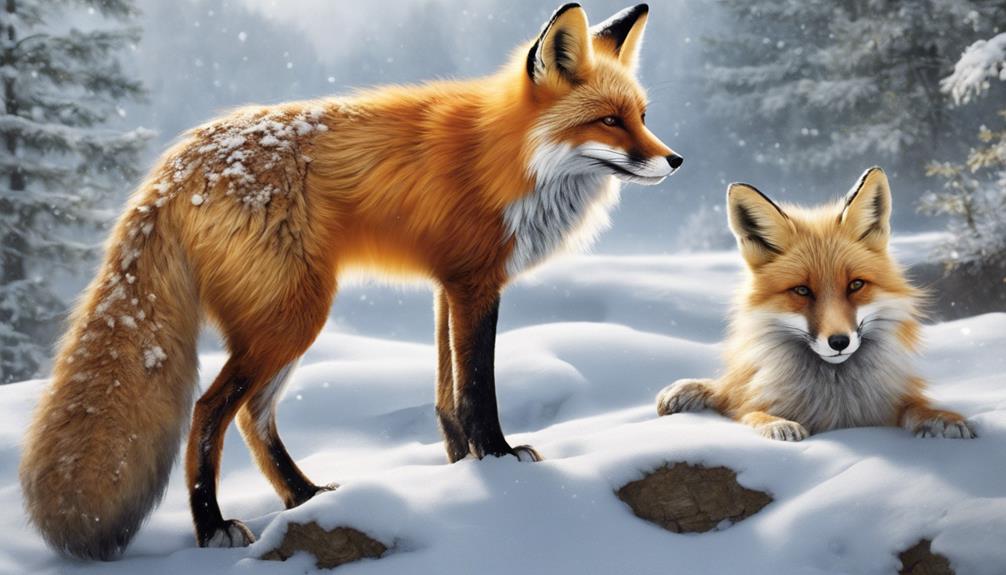
Decoding the distinct characteristics of fox and dog tracks offers valuable insights into their movements and behaviors. Fox tracks typically have elongated prints with a large gap between pads, while dog tracks appear wider and more rounded, with shorter, thicker claws.
To differentiate between the two, examining the track patterns is essential. Foxes often display purposeful and linear track patterns, with dense fur between pads, especially noticeable in winter. They tend to have a small straddle and may direct register, a behavior where they place their rear feet where their front feet were.
When observing tracks in the wild, noticing how foxes trot diagonally with hind feet on one side and front feet on the other can help distinguish them from dogs. Additionally, placing blades of grass in an X shape between pads can aid in identifying fox tracks, as this species tends to move in a more streamlined and deliberate manner compared to dogs.
Frequently Asked Questions
Who Would Win a Fox or a Dog?
When considering a hypothetical confrontation, it's important to weigh factors like size, strength, and behavior.
In a matchup between a fox and a dog, the outcome may depend on these characteristics. Dogs, being larger and domesticated animals with a history of working alongside humans, could potentially have an advantage over foxes.
However, foxes are known for their agility and cunning, which could play a role in determining the winner of such a confrontation.
How Can You Tell the Difference Between a Fox and a Dog?
When differentiating between a fox and a dog, observe the track details closely. Fox tracks are narrow and diamond-shaped, with smaller, widely spaced pads and sharp claws.
Dogs leave wider, rounder prints with larger, closer pads and shorter, thicker claws. Foxes tend to show a purposeful, linear track pattern, occasionally directing register.
Paying attention to these distinctions will help you identify whether you're tracking a fox or a dog accurately.
Are Foxes Friendly With Dogs?
Foxes and dogs can develop friendships based on individual traits and socialization. Careful introductions and close monitoring are essential for their safety. While curiosity may spark between the two, caution is crucial to avoid conflicts. Proper supervision and training can foster peaceful coexistence in certain scenarios.
Is a Fox Basically a Dog?
A fox isn't basically a dog. While both belong to the same family, Canidae, they've distinct differences in genetics, behaviors, and adaptations.
Foxes are wild animals with unique survival skills, while dogs have been domesticated for thousands of years. Even though they share some physical traits, such as fur color, their chromosome numbers, habitats, and lifestyles set them apart.
Foxes and dogs are separate species with their own evolutionary histories and characteristics.
Conclusion
To sum up, when trying to differentiate between fox and dog tracks, it's important to carefully observe key differences in track patterns, paw print spacing, fur presence between pads, claw length, print size and shape, gait variations, and track linearity.
By analyzing these details closely, one can confidently determine whether the tracks belong to a fox or a dog. Remember, attention to detail is key in identifying these subtle differences in animal tracks.
Dana is our Lead Content Writer, bringing a wealth of knowledge and expertise to our team. With a background deeply rooted in animal studies and a profound love for all creatures, Dana is dedicated to crafting engaging and informative content that resonates with our audience. With Dana at the helm, you can trust that our content is accurate and engaging, catering to the diverse interests of animal enthusiasts everywhere.
Dogs
10 Unique Stray Cat Names in Your Favorite Game
Get ready to discover 10 unique stray cat names in your favorite games – from Sonic to Zelda, each name holds a special charm.
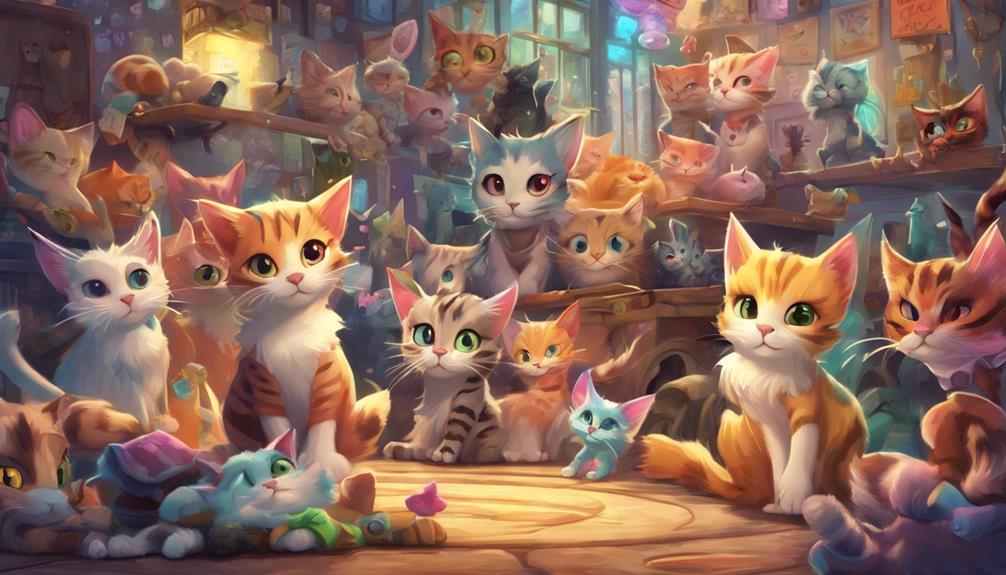
In our favorite games, we found unique names for stray cats: 'Sonic' for a swift feline, 'Knuckles' for a playful cat, 'Amy' for an independent kitty, and 'Tails' for a fluffy companion. Looking to Zelda? Consider 'Zelda,' 'Hyrule,' or 'Wisdom' for regal flair. 'Kratos' embodies strength, perfect for a bold cat. 'Cortana' offers assistance like in Halo. 'Ezio,' from Assassin's Creed, is mysterious and cunning – spot-on for cats. 'Ellie' shows survival skills, 'Nathan' is adventurous, and 'Tracer' is speedy. 'Aloy' portrays courage; perfect for a daring cat companion. Discover unique names inspired by beloved game characters.
Key Takeaways
- Choose 'Sonic' for a fast and energetic cat reminiscent of the video game character.
- Opt for 'Zelda' to reflect regal and powerful attributes inspired by Princess Zelda from Hyrule.
- Consider 'Kratos' for a bold and independent cat symbolizing strength and determination.
- Name your cat 'Ezio' to embody mystery, sophistication, and agility similar to the Master Assassin.
- Select 'Tracer' for a playful and energetic cat with rapid movements, quick reflexes, and a fun-loving nature from Overwatch.
Sonic – The Hedgehog
Exploring unique names for stray cats inspired by Sonic – The Hedgehog, a beloved video game series featuring a speedy blue hedgehog and his quirky companions, offers a fun way to connect our feline friends with this iconic universe.
When thinking of Cat Names influenced by Sonic, options like 'Sonic' itself could be an obvious yet fitting choice for a cat known for zooming around the house.
For a more mischievous kitty, 'Knuckles' might be a playful moniker, capturing the spirit of a strong and adventurous cat.
'Amy' could suit a sweet yet fiercely independent cat, reminiscent of Sonic's pink-haired companion.
Additionally, names like 'Tails' could be ideal for a fluffy cat with a playful demeanor, drawing inspiration from Sonic's loyal friend.
Whether your cat embodies speed, strength, sweetness, or playfulness, drawing from the world of Sonic can lead to some truly unique and delightful names for your beloved furball.
Zelda – Princess of Hyrule
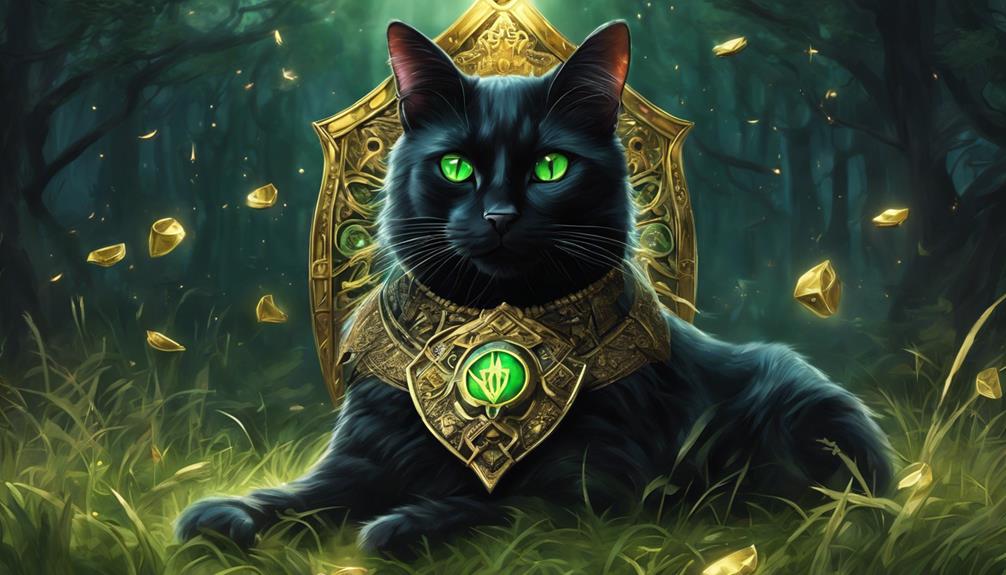
After discussing unique names for stray cats inspired by Sonic – The Hedgehog, let's now shift our focus to Zelda – Princess of Hyrule, a prominent figure in the Legend of Zelda series known for her wisdom and courage.
When considering a name for your feline friend inspired by Princess Zelda, you might want to reflect her regal and powerful attributes. Names like 'Zelda,' 'Hyrule,' 'Royal,' or 'Wisdom' could be fitting choices. These names capture the essence of Princess Zelda's character as a member of the Hylian royal family and her possession of magical abilities.
Alternatively, you could opt for names that highlight her courageous nature, such as 'Courage,' 'Brave,' or 'Heroine.' Princess Zelda's iconic status in the gaming world makes her a compelling source of inspiration for unique and meaningful names for your beloved stray cat.
Choose a name that resonates with you and embodies the spirit of this beloved character from the Legend of Zelda series.
Kratos – God of War
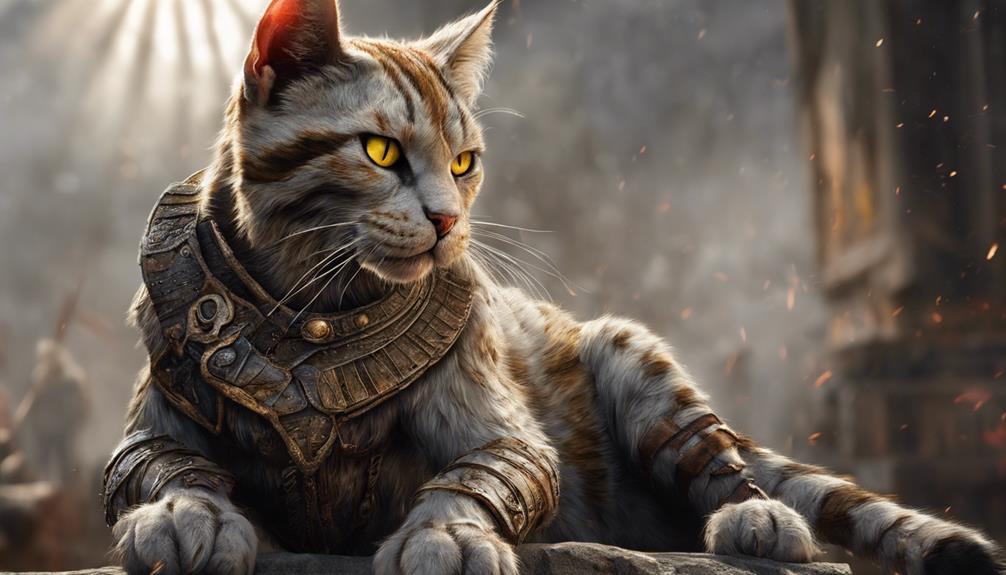
Kratos embodies a fierce warrior persona in the 'God of War' series, drawing inspiration from Greek mythology. His iconic Blades of Chaos make him a formidable force in battle, showcasing his strength and determination.
When considering names for a stray cat, Kratos could be a suitable choice for a strong and independent feline companion.
Kratos: Fierce Warrior Persona
Embodying the essence of a fierce warrior, Kratos, from the game 'God of War,' exudes unmatched determination and prowess in his quest for revenge against the gods of Olympus. As a demigod, his journey is filled with themes of vengeance and redemption, echoing the tales of Greek mythology.
With his powerful Blades of Chaos in hand, Kratos symbolizes strength and resilience, making him a formidable force in the gaming world. Players can immerse themselves in his story, channeling his unwavering resolve to overcome challenges and adversaries.
The persona of Kratos serves as an inspiration for those drawn to tales of epic battles and mythical conquests, embodying the spirit of a warrior on a relentless quest.
Video Game Inspiration
Drawing inspiration from the legendary warrior Kratos in the game 'God of War,' gamers can embody the spirit of relentless determination and mythical conquest in their own gaming adventures.
Kratos, with his iconic appearance and intense personality, is a powerful and fierce warrior seeking vengeance against the gods of Olympus. Armed with the Blades of Chaos, his pair of chained weapons with devastating power, Kratos stands out as a complex character with a tragic backstory.
Naming your stray cat after Kratos can infuse them with strength, determination, and a touch of mythology. Just like Kratos commands respect in the gaming world, your cat can exude a similar aura of power and resilience with a name inspired by this legendary figure.
Stray Cat Suitability
How suitable is the name Kratos from 'God of War' for a stray cat with a bold and independent personality? When considering naming a stray cat after Kratos, it's important to think about the cat's appearance and demeanor.
Here are three reasons why Kratos could be a fitting name for a strong and resilient feline:
- Reflects Toughness: Naming a stray cat Kratos can embody its survivor-like nature, especially if the cat displays a rugged appearance and a fearless attitude.
- Symbolizes Power: The name Kratos carries a sense of power and resilience, which can be perfect for a stray cat maneuvering the challenges of the wild with confidence.
- Adds Mythological Flair: Kratos is a unique name that adds a touch of mythological inspiration to your cat's identity, giving it a distinctive and memorable moniker.
Cortana – The AI Companion

Cortana, the AI companion in Halo, plays a pivotal role in providing assistance and information to the main character, Master Chief. Her origins and impact on gameplay are significant aspects that players appreciate and enjoy.
Understanding Cortana's role in the series enhances the overall gaming experience and deepens the emotional connection players have with the character.
Cortanas Origins and Role
With origins rooted in the AI program crafted by Dr. Catherine Halsey, Cortana serves as an essential companion and advisor to the protagonist, Master Chief, in the popular video game series, Halo.
- Cortana's creation by Dr. Halsey showcases the advanced technological capabilities within the Halo universe.
- Her role as Master Chief's guide highlights the importance of AI support in exploring complex gaming missions.
- Cortana's iconic blue holographic representation and witty demeanor enhance the player's emotional connection to the character, deepening the overall gaming experience.
These aspects combine to make Cortana not just an AI program, but a beloved and integral part of the Halo series, enriching the storytelling and gameplay.
Cortanas Impact on Gameplay
Essentially, interacting with Cortana in the Halo series greatly enhances the player's strategic decision-making and overall gaming experience. Cortana's impact on gameplay is profound, offering tactical advice, aiding in navigation, and driving the narrative forward. Through voice commands and dialogue options, players feel immersed in a world where their choices matter.
Cortana's character evolution and emotional complexity bring a unique layer to gameplay and storytelling, making the experience richer. Acting as Master Chief's trusted ally and confidante, Cortana deepens the player's connection to the game world, fostering a sense of camaraderie and purpose. Essentially, Cortana's presence elevates the gameplay by providing guidance, support, and a compelling relationship dynamic that enhances the overall gaming experience.
Ezio – Master Assassin

Stealthily roaming the streets, Ezio, the master assassin, strikes fear into the hearts of his enemies in the world of Assassin's Creed. His prowess in agility, stealth, and combat makes him a formidable figure in the gaming domain. As a Great Cat name inspiration, Ezio embodies mystery, cunning, and sophistication, perfect for a stray feline companion.
Here are three reasons why Ezio would be a fitting name for a stray cat:
- Mysterious Aura: Ezio's character is shrouded in mystery, much like the enigmatic nature of stray cats who often have unknown pasts and secretive behaviors.
- Agile and Cunning: Just as Ezio navigates through intricate scenarios with agility and cunning, stray cats exhibit similar traits in their movements and hunting skills.
- Sophisticated Presence: Ezio's story of revenge and redemption exudes sophistication, mirroring the dignified demeanor that many stray cats carry as they navigate their surroundings with grace.
Chell – Portals Protagonist

Ezio's stealth and cunning find a parallel in the silent yet determined protagonist, Chell, from the popular puzzle-platform game series, Portal. Chell, a resourceful female cat, is instantly recognizable by her distinctive orange jumpsuit and long-fall boots, which mirror her agility in traversing the intricate test chambers of the Aperture Science Enrichment Center.
Armed with a portal gun that allows her to create inter-spatial portals, she embodies both intelligence and courage, traits that make her a fascinating character for players to control. Despite her silence, Chell's actions speak volumes as she explores further into the mysteries of the facility.
Much like a cat investigating a new environment, she moves with purpose and curiosity, unraveling secrets with each carefully calculated step. Chell's enigmatic backstory adds depth to her persona, inviting players to speculate on her past while guiding her towards a brighter, portal-filled future.
Ellie – The Last of Us Survivor

Ellie's survival skills in 'The Last of Us' are impressive, showcasing her ability to navigate dangerous situations with courage.
Her impact on players is profound, as many admire her resilience and determination in the face of adversity.
Naming a stray cat after Ellie can serve as a tribute to her character traits and the emotional journey she undertakes in the game.
Ellies Survival Skills
In the post-apocalyptic world of The Last of Us, Ellie's survival skills shine brightly, showcasing her resourcefulness and combat prowess. Here are three key aspects of Ellie's exceptional abilities:
- Stealth Mastery: Ellie excels in moving undetected through dangerous territories, utilizing cover and distractions to outmaneuver foes.
- Resourceful Adaptation: Ellie demonstrates a keen ability to improvise weapons and tools from everyday objects, making the most out of limited resources in challenging situations.
- Expertise in Combat: Ellie's combat skills are exceptional, whether it's using firearms or hand-to-hand combat, she can hold her own against even the toughest adversaries.
Ellie's survival skills not only make her a formidable survivor but also a fan favorite among players for her tenacity and intelligence in the face of adversity.
Impact on Players
Players immersing themselves in the world of Stray find a unique opportunity to personalize their gaming experience by naming the cat protagonist. Choosing the perfect feline moniker allows us to establish a personal connection with our virtual companion, enhancing our emotional investment in the game. The cats name holds significance beyond mere identification; it becomes a symbol of our bond with the digital world we inhabit. To highlight the impact of this naming process, let's explore a table showcasing the diverse naming options available to players:
| Simple Names | Creative Names | Unique Names | Elaborate Names |
|---|---|---|---|
| Whiskers | Luna | Shadow | Sir Purrington |
| Mittens | Casper | Saffron | Duchess Meowington |
| Felix | Stardust | Zephyr | Captain Whiskerbeard |
Each choice reflects our individuality, making the game experience more personal and memorable.
Nathan – The Uncharted Adventurer
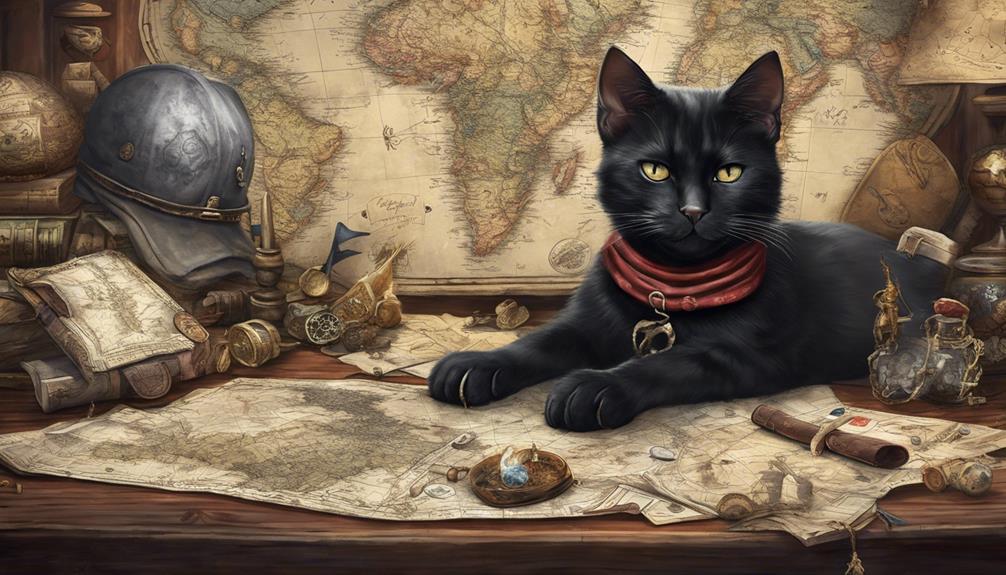
Setting out on exciting adventures through ancient ruins and exotic locales, Nathan enchants players as the charismatic and daring protagonist of the Uncharted game series.
Nathan's charm and wit make him an endearing character, fostering a strong connection with players who appreciate his adventurous spirit.
His exploration of ancient ruins and pursuit of hidden treasures add an element of intrigue and thrill to the gameplay experience.
Nathan's character, a mix of treasure hunter, historian, and action hero, presents a multifaceted persona that resonates with fans of the series.
With his engaging personality and thrilling exploits, Nathan's name could be a suitable and unique choice for a cat that embodies qualities of curiosity, bravery, and a sense of adventure.
Just like Nathan, a cat named after this cherished video game character may set off on its own little explorations and enthralling escapades around the house.
Tracer – Overwatchs Speedster
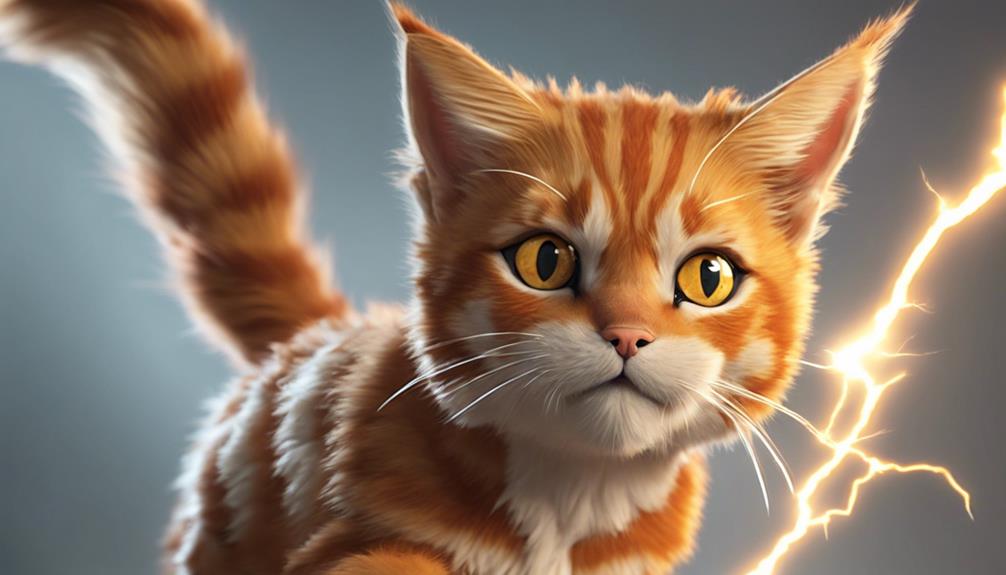
When considering a name for a fast and agile stray cat, Tracer from Overwatch emerges as a popular and fitting choice. The character Tracer is known for her exceptional speed and agility in the game, making her a perfect inspiration for a cat that embodies those qualities. Naming your cat after Tracer can bring a touch of gaming excitement to your furry friend's identity.
To highlight why Tracer is a great choice for your speedy feline companion, let's take a look at some key aspects of the character:
| Traits | Description |
|---|---|
| Speed | Known for rapid movements and quick reflexes. |
| Agility | Can dart around obstacles with ease. |
| Energetic | Always full of energy and ready for action. |
| Memorable | Tracer's unique design and abilities make her stand out. |
| Fun | A playful and fun-loving character that brings joy. |
Choosing the name Tracer for your cat can infuse a sense of adventure and liveliness into your pet's persona.
Aloy – Horizon Zero Dawns Brave Hunter

After considering the name Tracer for a speedy and agile stray cat, turning our attention to Aloy, the brave hunter from Horizon Zero Dawn, brings forth a new dimension of courage and skill for potential feline namesakes. Aloy's character embodies qualities that many cat owners may wish to bestow upon their new furry companions. Here are some reasons why naming your stray cat after Aloy could be a fitting choice:
- Courage: Aloy is known for her fearless nature and determination in the face of challenges, making her name a symbol of bravery for your adventurous feline friend.
- Skill: Just like Aloy's expertise in archery and combat, naming your cat after her reflects a sense of agility and prowess that many cat owners admire in their pets.
- Resilience: Aloy's resilience in a harsh post-apocalyptic world serves as an inspiration for strength and adaptability, qualities that can resonate with the spirited nature of stray cats finding their way in the world.
Frequently Asked Questions
What Is a Good Name for a Stray Cat?
We think a fitting name for a stray cat should mirror their distinct characteristics and the emotions they evoke in us. It is crucial to contemplate the cat's personality, appearance, and the happiness they bring us each day.
What Is the Cats Name in the Game Stray?
In Stray, we choose the cat's name. The game allows us to be creative and bond with the furry protagonist. We feel a sense of ownership and connection, making our experience unique and personal.
What Is the Rarest Cat Name?
The rarest cat names are those that are truly unique, capturing individuality and sparking curiosity. They stand out, making our pets even more special. Choosing a rare name adds a touch of magic to our furry friends' identities.
What Is the Coolest Cat Name?
The coolest cat name is subjective, but we love brainstorming unique names that reflect the feline's personality and charm. It's a fun challenge to find that purrfect name that truly captures the essence of our furry friend.
Conclusion
To sum up, naming your stray cat after a beloved character from your favorite game can add a touch of uniqueness and personality to your furry companion.
Whether you choose Sonic, Zelda, Kratos, or any other character, the name you pick can reflect your interests and create a special bond between you and your pet.
So, have fun choosing a name that suits your cat's spirit and enjoy the companionship of your new gaming-inspired feline friend.
As our Editor-in-Chief, James plays a pivotal role in ensuring the quality and integrity of our content. With a keen eye for detail and a passion for storytelling, James oversees the editorial process here at A Place for Animals. With years of experience in content editing, James ensures that every piece of content meets our high standards of accuracy and clarity. Under James’ guidance, you can rest assured that the content you read is informative and impeccably crafted.
Dogs
Is Ivy Toxic to Dogs?

Ivy is toxic to dogs due to saponins and polyacetylene compounds, most concentrated in the leaves. Eating it can lead to stomach problems. Look for signs like nausea, drooling, and skin irritation. Dog size and health affect severity. Seek vet help promptly if ingestion is suspected. Contact a vet immediately and rinse mouth if ingestion happens. Don't induce vomiting without professional advice. Quick vet care improves recovery chances. Keep ivy out of reach, consider non-toxic plants, and remove ivy from your dog's area. Stay proactive in pet-proofing your space. Understanding these dangers can help keep your furry friend safe.
Key Takeaways
- Ivy contains toxic saponins and polyacetylene compounds harmful to dogs.
- Toxic components are most concentrated in the leaves of the ivy plant.
- Ingestion can lead to gastrointestinal issues in dogs.
- Seek immediate veterinary assistance if ivy ingestion is suspected.
- Prevention involves keeping ivy out of reach and opting for non-toxic plant alternatives.
Potential Risks of Ivy to Dogs
When considering the potential risks of ivy to dogs, it's important to be aware of the toxic chemicals present in all parts of the plant. Ivy, a common plant known for its climbing vines and distinctive leaves, contains harmful substances like saponins and polyacetylene compounds that can be hazardous if ingested by dogs.
These toxic components are most concentrated in the leaves of the plant, making them particularly risky for our canine companions. Ingestion of ivy by dogs can lead to a range of symptoms, from mild gastrointestinal issues such as nausea and drooling to more severe conditions like abdominal pain, diarrhea, and vomiting.
It's essential to seek prompt veterinary assistance if you suspect your dog has consumed ivy to guarantee proper treatment and increase the chances of a full recovery. Remember, the well-being of our furry friends is paramount, and quick action is key in combating the potential dangers of ivy toxicity.
Recognizing Signs of Ivy Toxicity

Moving from discussing the potential risks of ivy to dogs, it's important to recognize the signs of ivy toxicity in our canine companions. Ivy is a toxic plant that can be poisonous to dogs. Symptoms of ivy toxicity include nausea, drooling, abdominal pain, diarrhea, and vomiting. Skin contact with ivy can lead to irritation, blistering, redness, and swelling in dogs.
The severity of symptoms varies depending on factors such as the dog's size, health, and the amount of ivy ingested. Larger dogs may experience milder symptoms compared to smaller dogs ingesting the same amount of ivy. Additionally, repeated exposure to ivy sap can cause allergic dermatitis in dogs.
Being aware of these symptoms and the effects of ivy ingestion or skin contact is essential in safeguarding our furry friends from the potential dangers of this toxic plant.
Responding to Ivy Ingestion in Dogs

If your dog has ingested ivy, contact your vet immediately to guarantee prompt treatment. Ivy poisoning can be toxic to dogs, leading to symptoms like nausea, drooling, abdominal pain, diarrhea, and vomiting. It's important to seek veterinary help as soon as possible to ensure the best outcome for your furry friend.
Before heading to the vet, rinse your dog's mouth and skin with cool water to remove any remaining ivy residue. While monitoring your dog for any signs of distress, remember to avoid inducing vomiting or trying home remedies without proper guidance from a professional. Early veterinary intervention greatly increases the chances of a full recovery for your pet.
Veterinary Care for Ivy Toxicity
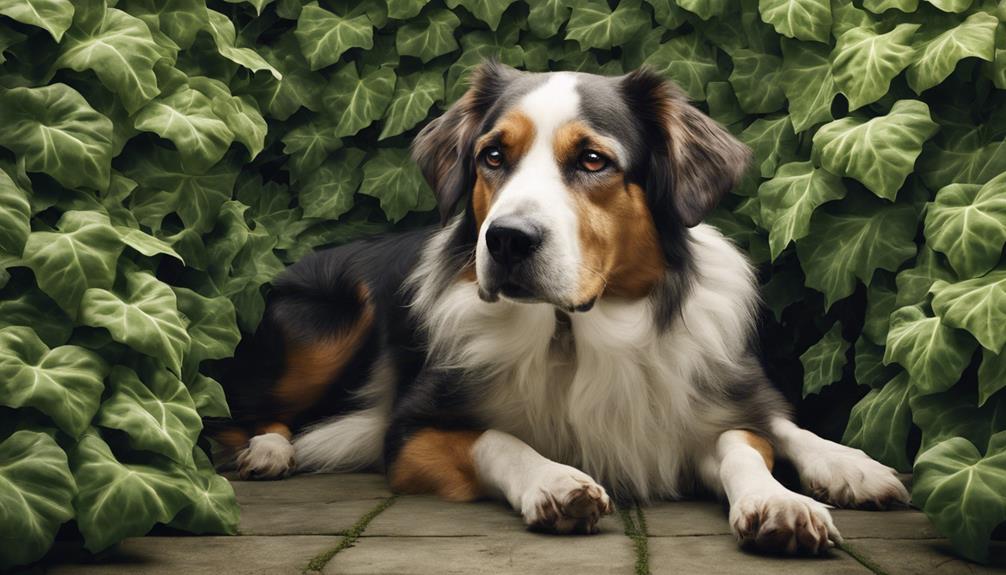
When a dog shows symptoms of ivy toxicity, such as nausea and diarrhea, it's crucial to seek immediate veterinary care. Veterinarians may rinse the dog's mouth and skin, administer IV fluids, and offer treatments like antihistamines.
Owners should closely follow the vet's guidance to guarantee a safe and effective recovery for their furry companions.
Symptoms of Ivy Toxicity
Upon observing symptoms of ivy toxicity in a dog, immediate veterinary care should be sought to address the potential poisoning. Symptoms of ivy toxicity may manifest as nausea, drooling, abdominal pain, diarrhea, and vomiting. Additionally, dogs may experience skin reactions such as blistering, redness, and swelling upon contact with the toxin.
To provide relief before reaching the vet, rinse the dog's mouth and skin with cool water to remove irritants. However, it's essential to seek professional veterinary care for proper evaluation and treatment. Supportive treatments like IV fluids and pain relief may be necessary to manage the symptoms effectively.
Treatment Options Available
After observing symptoms of ivy toxicity in a dog, immediate veterinary care is essential to address potential poisoning. Treatment options such as rinsing the dog's mouth and skin with cool water can help remove irritants from English ivy. Veterinarians may also administer supportive treatments like intravenous fluids, antihistamines, and pain relief as needed.
In cases of vomiting or diarrhea, providing plenty of fluids is important to prevent dehydration. Most dogs can recover from ivy poisoning within hours to days, depending on the severity of the intoxication. Early intervention by a vet greatly increases the chances of a full recovery for dogs exposed to toxic substances from English ivy.
Prevention Tips for Owners
To avoid ivy toxicity in dogs, owners should make sure that ivy plants are kept out of reach to prevent potential poisoning risks. English ivy is toxic to dogs, so it's essential to opt for safer plant options that won't harm your pet's health.
Remove any ivy from bouquets and surroundings to reduce the risks of ingestion. By eliminating ivy from your home and exploring pet-friendly plant options, you can create a safer environment for your furry friend.
Prevention is key in keeping your pets safe from the dangers of toxic plants like ivy. Stay vigilant and proactive in choosing plant options that are non-toxic to dogs to ensure their well-being and health.
Preventing Ivy Poisoning in Dogs
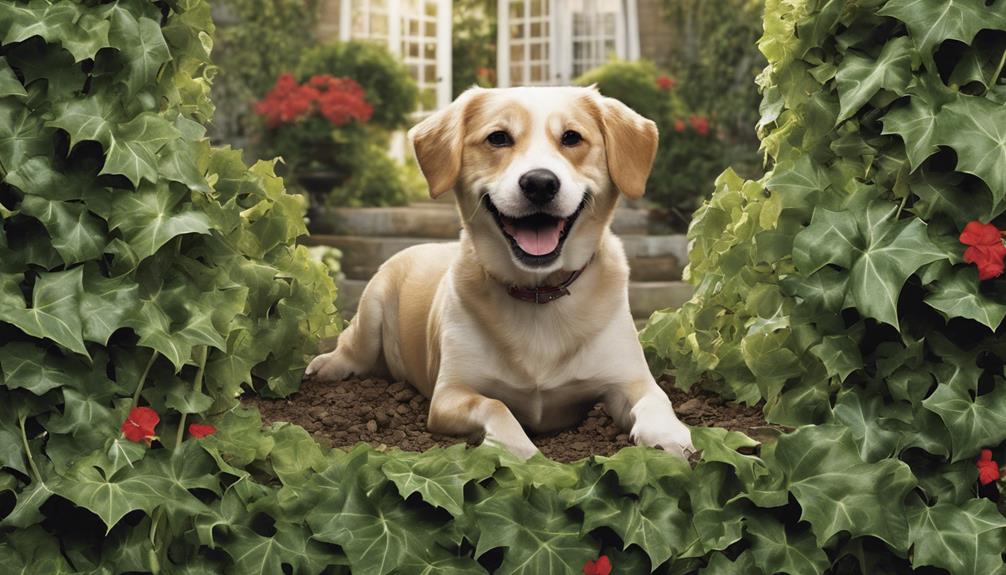
To prevent ivy poisoning in dogs, it's essential to keep ivy plants out of reach at all times. English ivy can be toxic to pets, leading to potential poisoning if ingested. As responsible pet owners, we must prioritize our dogs' safety by opting for safer plant alternatives that won't harm their health. Consider removing any ivy from bouquets or surroundings where your dog may have access to, reducing the risks of poisoning to a large extent. By eliminating ivy from your home altogether, you not only prevent poisoning but also create a healthier environment for your beloved pet.
Exploring plant alternatives that are pet-friendly is a proactive step towards ensuring your dog's well-being. Look for options that are non-toxic and safe for pets to be around. By making these small adjustments, you can enjoy a beautiful home environment without putting your dog at risk of ivy poisoning. Remember, a little precaution goes a long way in keeping your furry friend safe and healthy.
Additional Resources for Ivy Toxicity
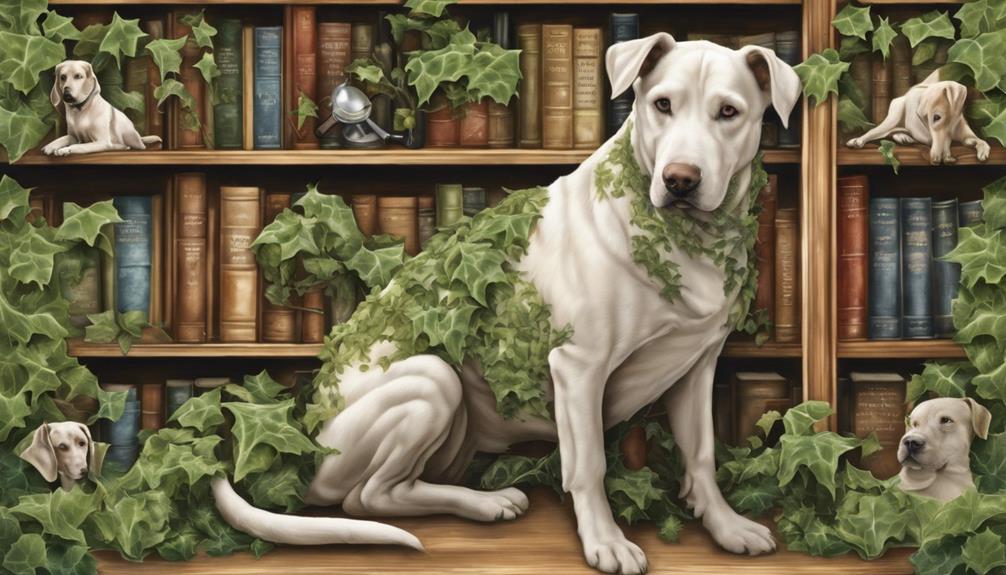
Upon encountering concerns about ivy toxicity in dogs, we sought additional resources to deepen our understanding of the potential risks and solutions. English ivy poses a threat to our furry friends due to compounds like saponins and polyacetylene, which can lead to symptoms such as nausea, drooling, and abdominal pain if ingested. If your pet shows any signs of ivy poisoning, it's essential to seek veterinary advice immediately. Treatment may involve rinsing the mouth, providing supportive care, and monitoring for dehydration to guarantee a speedy recovery.
To prevent such incidents, consider pet-friendly plant alternatives and keep English ivy out of your dog's reach. Swift action is key, as larger doses of ivy can result in more severe symptoms. Remember, skin contact with this plant can also cause irritation, blistering, and swelling. By staying informed and proactive, you can create a safe environment for your beloved pet and avoid the dangers of ivy toxicity.
Frequently Asked Questions
What Happens if Dogs Eat Ivy?
If dogs eat ivy, they can experience symptoms like nausea, drooling, abdominal pain, diarrhea, and vomiting. Larger dogs may have milder reactions than smaller dogs for the same amount ingested.
The leaves of the plant have the highest concentration of toxins. Repeated skin contact can lead to irritation, blistering, redness, and swelling. Prolonged exposure to ivy sap might cause allergic dermatitis in dogs.
It's essential to keep your pets away from ivy to prevent these issues.
What Ivy Is Safe for Dogs?
We've found that Swedish Ivy, with its safe and non-toxic properties for dogs, is a fantastic choice for pet owners. Its easy care and adaptability to different lighting conditions make it a popular hanging plant.
Remember to watch your dog's interactions to avoid ingestion.
What Is the Most Toxic Plant to Dogs?
When it comes to the most toxic plants for dogs, the Sago Palm takes the top spot. Ingesting any part of this plant, from roots to leaves, can lead to severe symptoms like liver failure.
Signs of poisoning include vomiting, diarrhea, and abdominal pain, requiring immediate vet care. It's important for pet owners to keep Sago Palms out of reach to prevent accidental ingestion and potential life-threatening consequences.
Is English Ivy Toxic to Animals?
English Ivy contains toxins that can be harmful to animals. The leaves have the highest concentration of toxins, posing a greater risk.
Symptoms of poisoning include gastrointestinal distress, vomiting, diarrhea, and skin irritation. While not usually life-threatening, it can cause discomfort.
Contact may also lead to skin reactions like blistering and swelling.
It's important to be cautious around English Ivy to keep our furry friends safe and healthy.
Conclusion
In summary, it's important to be aware of the potential risks of ivy to dogs and take necessary precautions to prevent toxicity.
Recognizing the signs of ivy ingestion and seeking prompt veterinary care can make a significant difference in your pet's health and well-being.
By being proactive and informed, you can guarantee that your furry friend stays safe and healthy, free from the dangers of ivy poisoning.
Stay vigilant and keep your pup out of harm's way!
Dana is our Lead Content Writer, bringing a wealth of knowledge and expertise to our team. With a background deeply rooted in animal studies and a profound love for all creatures, Dana is dedicated to crafting engaging and informative content that resonates with our audience. With Dana at the helm, you can trust that our content is accurate and engaging, catering to the diverse interests of animal enthusiasts everywhere.
Dogs
Unveiling Houdinis Name: Revealing the Meaning
Step into the enigmatic world of Houdini as we unravel the mystery behind his name, revealing a blend of tribute and personal connections that shaped his legendary persona.

Revealing Houdini's name uncovers a deep blend of tribute and personal connections intertwined with his legendary persona. From Ehrich Weiss to Harry Houdini, the transformation signified reinvention and admiration for magical trailblazers. The change honored his father and magician Robert-Houdin, showcasing personal lineage. Houdini strategically boosted his reputation by connecting with audiences and cementing his position as an entertainment icon. His lasting legacy in magic remains synonymous with enigma, deception, and unmatched showmanship, molding the landscape of entertainment. Explore more about Houdini's name to gain understanding of the intricate layers of his magical journey.
Key Takeaways
- Houdini's name change honored his father and magician Robert-Houdin.
- The name 'Harry' was inspired by magician Harry Kellar.
- 'Ehrich' and 'Weiss' reflected his birth name and Hungarian heritage.
- The name transformation symbolized reinvention and homage.
- Houdini's name change elevated his status and solidified his place in entertainment history.
Houdinis Early Life and Name Origins
Exploring Houdini's early life and the origins of his name reveals a fascinating journey intertwined with family heritage and a passion for magic. Born as Ehrich Weiss on March 24, 1874, in Budapest, Hungary, Houdini later adopted the name Ehrich Weiss upon his immigration to the United States. His family background played a significant role in shaping his future as a magician, with ties to a renowned European magician. Houdini's father, a former lawyer turned rabbi, instilled values that influenced his son's career choices.
As Houdini probed into the world of magic, he faced a turning point driven by ethical considerations. He made a conscious decision to distance himself from fraudulent spiritualism, a practice prevalent during his time. This pivotal moment not only shaped his career but also defined his stance on ethical boundaries within the domain of magic. Houdini's early life was a mosaic of influences that laid the foundation for his iconic persona as a magician dedicated to authenticity and skill.
The Evolution of Houdinis Stage Persona

How did Houdini's stage persona transform from Ehrich Weiss to the legendary Harry Houdini?
The evolution of Houdini's stage persona was a carefully orchestrated process that led to the creation of a fascinating and mysterious character. Drawing inspiration from his admiration for magician Harry Kellar, Houdini adopted the name 'Harry' to add a touch of prestige and flair. Additionally, by incorporating 'Houdini' into his stage name as a nod to the renowned French magician Jean Eugène Robert-Houdin, Houdini added an aura of mystique and sophistication to his persona.
This evolution from Ehrich Weiss to Harry Houdini played a pivotal role in shaping his legendary status in the world of magic and escapology. The combination of these elements helped Houdini establish himself as a master of illusion and a figure of intrigue, setting the stage for a career filled with mesmerizing performances and extraordinary feats of magic.
Symbolism in Houdinis Name
Houdini's name, a rich tapestry of symbolism, weaves together elements of heritage, reinvention, and homage to magical pioneers. Originally known as Ehrich Weiss, Houdini's name transformation symbolized his journey of reinvention and escape into the world of legendary magicians. The shift from Ehrich Weiss to Harry Houdini not only honored his father, Harry Houdini, Sr., who instilled in him a love for magic but also paid tribute to the renowned French magician Robert-Houdin, reflecting Houdini's deep respect for his magical predecessors.
The incorporation of 'Houdini' into his name was a nod to his admiration for Robert-Houdin, showcasing his reverence for the magic industry's trailblazers. Additionally, the name 'Ehrich Weiss' held significance as 'Ehrich' reflected his birth name, while 'Weiss' represented his Hungarian heritage. Houdini's chosen name encapsulated layers of symbolism, intertwining his personal connections, heritage, and profound respect for the magical arts.
Houdinis Name Change and Impact

Upon adopting the name 'Houdini,' the renowned magician solidified his place as a trailblazer in the world of magic and entertainment.
The transformation from Ehrich Weiss to Houdini wasn't merely a change in nomenclature but a deliberate homage to Jean Eugène Robert-Houdin, a magician Houdini greatly admired.
This name change wasn't just about personal branding; it was a strategic move to craft a spellbinding stage persona that would resonate with audiences.
By rechristening himself as Houdini, the magician elevated his status from a performer to an icon in the domain of magic and escape artistry.
The impact of this decision reverberated throughout his career, bolstering his credibility and solidifying his place in the annals of entertainment history.
Houdini's name change wasn't just a superficial alteration; it was a pivotal moment that propelled him towards legendary status, shaping the course of his magical journey.
Legacy of Houdinis Name
Houdini's enduring legacy in the world of magic and entertainment is intricately intertwined with the mystique and grandeur associated with his iconic name. The name 'Houdini' has transcended time, becoming synonymous with mystery, illusion, and unparalleled showmanship. Harry Houdini's magical persona, especially his daring escape acts, has solidified his place as a legend in popular culture. The impact of Houdini's name is undeniable, evoking awe and fascination, even in contemporary times.
His name remains a symbol of extraordinary skill, daring feats, and legendary performances that captivate audiences across generations. The enduring impact of Houdini's legacy serves as a confirmation to his unparalleled influence on the world of magic and entertainment, showcasing the lasting power of his iconic name.
As we explore the legacy of Houdini's name, we uncover a rich tapestry of illusion, mystery, and showmanship that continues to shape the landscape of magic and entertainment.
Frequently Asked Questions
What Is the Meaning of the Word Houdini?
The meaning of the word 'Houdini' originates from the French magician Jean Eugène Robert-Houdin, adopted by Erich Weiss. It pays tribute to Robert-Houdin, enhancing Weiss's magical persona. The name change reflects admiration for Robert-Houdin's legacy.
What Was the Message From the Grave Houdini?
We decoded Houdini's message from the grave, a loving 'Rosabelle BELIEVE' meant for Bess. The code was clever, challenging but rewarding. It revealed his skepticism of mediums even after his passing, showcasing his passion for truth.
Did Houdini Ever Reveal His Secrets?
We never shared his secrets. Houdini guarded them fiercely, adding to his mystique. The allure of mystery was crucial to his success. He believed in the impact of the unknown on his audience.
What Is the Meaning of Houdining?
We see 'Houdining' as breaking free from challenges with flair. It's about cleverly maneuvering obstacles. The term embodies using wit and determination to overcome limits. It's like pulling off an impressive feat of escape in life's tricky situations.
Conclusion
In unraveling the mystery behind Houdini's name, we've discovered a rich tapestry of history, symbolism, and legacy.
Like a hidden treasure waiting to be unearthed, his name holds clues to his remarkable journey and enduring impact on the world of magic.
Just as Houdini himself captivated audiences with his illusions, his name continues to mystify and intrigue, leaving us with a deeper appreciation for the man behind the magic.
As our Editor-in-Chief, James plays a pivotal role in ensuring the quality and integrity of our content. With a keen eye for detail and a passion for storytelling, James oversees the editorial process here at A Place for Animals. With years of experience in content editing, James ensures that every piece of content meets our high standards of accuracy and clarity. Under James’ guidance, you can rest assured that the content you read is informative and impeccably crafted.
-

 Vetted2 months ago
Vetted2 months ago15 Best Cat Foods for Managing Hyperthyroidism – Vet Approved and Feline Friendly
-

 Vetted2 months ago
Vetted2 months ago15 Best Dog Foods for Kidney Disease – Expert Recommendations for Your Pet's Health
-

 Vetted2 months ago
Vetted2 months ago14 Best Homemade Dog Food Recipes Your Pup Will Love – Vet Approved & Nutritious
-

 Vetted2 months ago
Vetted2 months ago15 Best Wet Cat Foods for Older Cats to Keep Them Healthy and Happy
-

 Vetted2 months ago
Vetted2 months ago15 Best Fresh Dog Food Delivery Services for Your Pup's Health and Happiness
-

 Animal Facts2 months ago
Animal Facts2 months agoSpring Animals: A Guide to Seasonal Wildlife
-

 Cats2 months ago
Cats2 months agoCat Weight Chart by Age: Kitten to Senior in Lbs
-

 Cats2 weeks ago
Cats2 weeks agoTop 5 Cat Breeders in Arkansas: A Guide





















